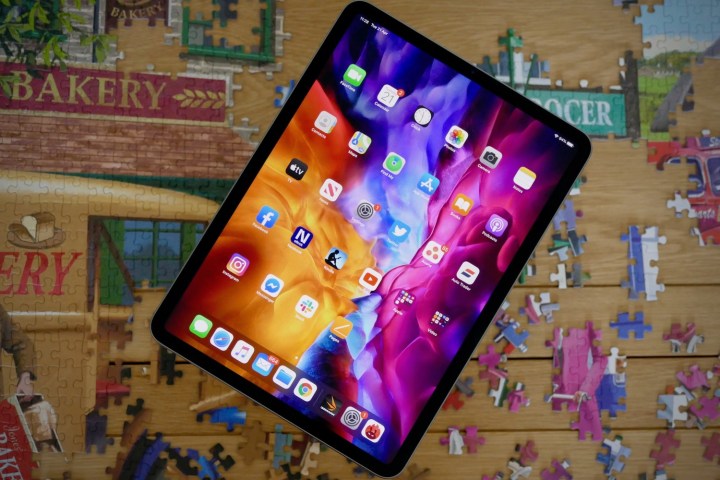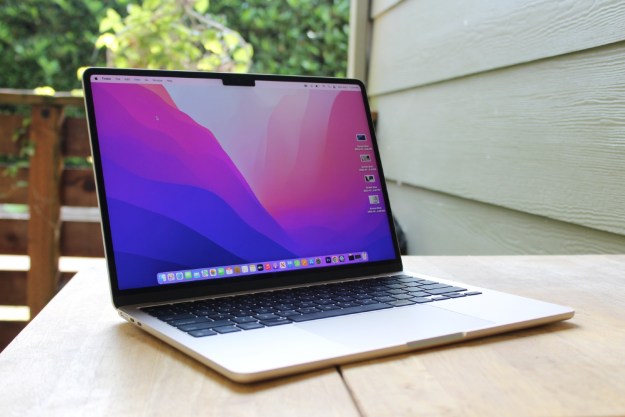If you’re looking for portable power in the Apple ecosystem, the MacBook Pro immediately leaps out. But the iPad Pro is also a very capable contender for your attention, especially after its 2020 update. The new compact frame, beefy processor, Apple Pencil support, and Magic Keyboard cover all make it a very strong choice for working on the go.
Apple often touts its iPads as computer replacements, which is more accurate than ever with the latest iPad Pros carrying the M1 processor found in Apple’s newest Macs. With such similar specs, can the iPad Pro become a viable alternative to the MacBook Pro?
Also, if you’re in the market for either device, take a look at some of the best Cyber Monday MacBook deals and iPad deals available now.
Design

The MacBook Pro and iPad Pro have vastly different designs, each with its own considerations. Let’s start with the iPad Pro.
The top-of-the-line iPad comes in 11-inch and 12.9-inch sizes, along with Space Gray and silver color options. The company completely redesigned the iPad Pro in October 2018 to feature much thinner bezels and a flat-edged chassis. Apple refined that new design even further in March 2020, bringing Magic Keyboard and trackpad support to its top-end tablet.
Currently on the back is a 10-megapixel ultrawide camera, a 12MP wide-angle camera, and a lidar sensor. Along the flat edge is Apple’s magnetic Smart Connector for attaching accessories like external keyboards. This flat edge allows the second-generation Apple Pencil to magnetically attach for a wireless recharge. In older models, the Apple Pencil awkwardly stuck out of the Lightning port like a sword.
The iPad Pro is 0.23 inches thick, making it Apple’s thinnest iPad. Weighing between 1.04 pounds and 1.42 pounds (depending on size and configuration), it’s light enough to throw in a backpack and take wherever you go.
The MacBook Pro is a very different beast.
The M1 model comes with a 13.3-inch display. Compared to the iPad Pro, those larger dimensions mean the weight increases, too, tipping the scales to 3 pounds, double the weight of the larger 12.9-inch iPad Pro. Part of that is due to the all-metal chassis, but it gives the MacBook Pro real stability. Both devices are extremely well-made and feel truly premium — no flimsy plastic casings here.
There are other similarities, too, such as how both use USB-C ports. The 2021 iPads will launch with a Thunderbolt 3/USB-4, which will allow for data transfer speeds up to 40Gb per second. That’s four times the amount possible on last year’s models and on par with the connections available on the MacBook Pro. That also makes the iPad Pro compatible with Thunderbolt docks and displays, including Apple’s Pro Display XDR at the full 6K resolution. However, it still only comes with one port, whereas the M1 MacBook Pro comes with two.
Unfortunately, neither device allows much in the way of modularity or component changes after purchase. While that may be unsurprising for a tablet, it’s slightly more unusual for a laptop. Changing any component in a MacBook Pro, from the memory to the solid-state drive, is a pretty involved task requiring various tools and plenty of patience.
Whichever device you choose, make sure you’re happy with the configuration before making a purchase.
Features

The iPad Pro’s key feature is its display. Apple has not skimped here, equipping its top-tier tablet with a superb screen that’ll make working on the go a joy. We said the recent 2020 model was “the best version of the best tablet you can buy” in our review, and that’s just as true today.
For starters, the display’s True Tone feature automatically adjusts its white balance according to the surroundings, making viewing easier on the eyes. It doesn’t sound like much, but it really makes a difference in use.
The iPad Pro also uses the same Liquid Retina tech seen in the iPhone XR. The display has a 2732 x 2048 resolution in the 12.9-inch model and 2388 x 1668 in the 11-inch device. Apple’s ProMotion tech automatically adjusts the refresh rate up to 120Hz — double the refresh rate of the MacBook Pro. The result is a super-smooth experience and an incredibly natural feel when using the Apple Pencil.
The 2021 12.9-inch iPad also includes Apple’s Liquid Retina XDR display — which is needlessly wordy but cool nonetheless. This mini-LED display pushes the display up to 1,000 nits of brightness, with 1,600 nits of peak brightness for HDR content. It also has a stunning 1,000,000:1 contrast ratio, thanks in large part to the 10,000 individual LEDs across 2,500 local dimming zones packed into the tiny frame.
Apple overhauled the Apple Pencil alongside the iPad Pro in 2018. It now features a flat edge, so it magnetically clips to the tablet’s flat edge to receive a charge. It essentially turns the iPad Pro into a digital notebook — just double-tap it on the screen to change from a pencil to an eraser, for example. It’s great for freehand drawing and writing tasks.
Moving to the MacBook Pro, which features an IPS Retina display with a 2560 x 1600 resolution and TrueTone technology. It enjoys Apple’s superior Magic Keyboard, which was introduced with the refreshed 13-inch MacBook Pro in May 2020. We found it to be the best Mac keyboard to date and a significant upgrade over the older butterfly keyboard.
Both MacBook models have an oversized trackpad that works with a huge range of MacOS gestures. While the trackpad feels clicky, it doesn’t physically move when pressed — it simply uses haptic feedback to simulate that clicky movement. It’s superb and easily the best and largest currently available on a laptop, beating its Windows rivals.
There’s also the Touch Bar to consider. It replaces the function keys with an OLED strip that presents interactive shortcuts to various common tasks. These shortcuts change depending on the app. Mac owners can even customize the Touch Bar to add or remove buttons as needed.
Complementing the Touch Bar is a power button with Apple’s Touch ID sensor sitting directly to the right. Touch ID enables quick logins and immediate purchase verifications using just a finger.
Finally, MacOS is a mature system supporting plenty of heavy-duty apps, like Adobe Premiere. It’s built for a computer, so users can install traditional desktop software. The default input is through a keyboard and mouse (or tracked on laptops).
Meanwhile, the iPad Pro runs iPadOS, which Apple spun from iOS. It’s far less established than MacOS and, while a very good operating system in its own right, it doesn’t support desktop software. It’s built for mobile, meaning it relies on touch-based input and only offers apps through the App Store. It does, however, now support trackpad gestures, which bring it a little closer to MacOS.
That said, Apple now provides developers with better support for porting their iPad apps over to the Mac thanks to Mac Catalyst and MacOS Big Sur, so things may change. The line separating the two should eventually disappear as Apple moves all Macs over to in-house processors.
Overall, both platforms have app advantages — the iPad Pro has the benefit of the robust iOS app ecosystem, while the MacBook Pro has the professional native desktop apps the iPad Pro lacks.
Performance

The latest MacBook Pro 13 from 2020 has something extra to consider. The $1,299 and $1,499 models now use Apple’s in-house M1 processor rather than an Intel chip. In our review for the M1 MacBook Pro, we called it “the most exciting Mac in years.” And we meant it. The power of the M1 chip combined with the incredible battery life makes for a truly great laptop experience. The MacBook Pro is even capable of gaming, thanks to the M1 chip.
The 2021 iPad Pros include the M1 processor as well — the same as found on the MacBook Pro, MacBook Air, Mac Mini, and the recently released 24-inch iMac. Apple has boasted a performance boost of 50% from the last generation, which is a giant leap forward. And, by all accounts, that story checks out. The M1 is powerful and puts the iPad Pro miles ahead of the competition.
However, as impressive as that sounds, the choice to put the M1 in the iPad Pro is also a puzzling one. The iPad Pro was already the most powerful tablet available, and there aren’t any apps that can push it to the limit. Part of that is the limitations of iPadOS. Fans of the tablet hoped WWDC back in June would reveal some major changes for the operating system, but iPadOS was a tiny fraction of the event and featured no earth-shattering changes. For now, the iPad Pro can hardly utilize the impressive hardware within it.
The MacBook Pro’s power and flexibility win

Ultimately, any decision you make when choosing between devices like these will be influenced by two factors: Price and software.
Despite the new iPads having the same processor and the incredible Liquid Retina XDR on the 12.9-inch model, we still think the M1 MacBook Pro is the better value. The 12.9-inch model starts at $1,099, and for just $200 more, you could get the entry-level MacBook Pro.
Unless something changes for iPadOS that allows it to utilize the power of the M1 processor, the MacBook Pro just makes more sense. If you’re a working professional, Apple’s top-of-the-line laptop is the best choice for you.
That isn’t to say that the iPad Pro isn’t a great option. If you love the mobile nature of the iPad and it has all the apps you need, it’s still a great choice. The Liquid Retina XDR display, in particular, would be great for watching HDR content or editing video in LumaFusion. And combined with the Apple Pencil and the Magic Keyboard, it’s a computer in its own right. It may just take some getting used to for those used to a standard desktop OS.
If you’re set on the tablet but turned off by the Pro’s price, the iPad Air functionally does everything the iPad Pro does, has a similar design, and has a more recent A14 chip, all for a lower cost.
Even if you can afford either product, how you will use that product ultimately steers your purchase decision. If you need to run desktop software, then the iPad Pro will be a waste of money. However, if you’re content with everything provided under the App Store banner and want a portable, touch-based device, then the iPad Pro may be ideal.
Editors' Recommendations
- Best Apple deals: Save on AirPods, Apple Watch, iPad, MacBook
- The 5 best MacBooks for video editing in 2024
- Best iPad deals: Save on iPad Air, iPad Pro, iPad Mini for the New Year
- Best MacBook deals: Get an Air for $605 and save on M3 MacBook Pro
- The MacBook Air 15 vs. MacBook Pro 14: the easy way to decide





